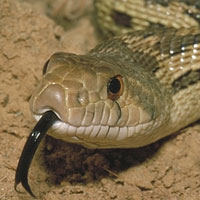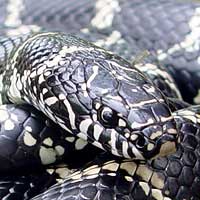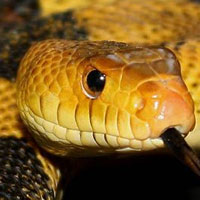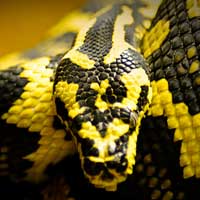Everything You Should Know About the Eastern Fox Snake
The Eastern Fox Snake, scientifically known as Pantherophis vulpinus, belongs to the Colubridae family, which is the largest family of snakes, encompassing a diverse range of non-venomous and mildly venomous species renowned for their adaptability and extensive distribution across various habitats worldwide.
Scientific Name: Pantherophis vulpinus
Snake Family: Colubridae
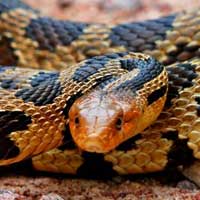
Introduction to the Eastern Fox Snake
The Eastern Fox Snake (*Pantherophis vulpinus*), native to the Great Lakes region of North America, is a non-venomous snake admired for its striking yellow-brown coloration and bold dark blotches. Often mistaken for rattlesnakes due to their defensive tail-shaking behavior, these snakes are harmless and beneficial for controlling rodent populations. With proper care, the Eastern Fox Snake makes a fantastic pet for experienced reptile keepers.
Crafting the Perfect Habitat for the Eastern Fox Snake
The Eastern Fox Snake thrives in environments that replicate its natural habitat, including wetlands, forests, and grasslands. Essential habitat elements include:
- Enclosure Size: A 40-gallon tank is suitable for adults, with additional space for enrichment.
- Temperature Gradient: Maintain daytime temperatures of 75-85°F, with a basking spot at 90°F, and nighttime temperatures of 65-70°F.
- Humidity: Keep humidity levels between 50-70%, achieved through misting and a water dish.
- Substrate: Use aspen shavings, coconut husk, or a soil-sand mix to mimic natural ground cover.
- Enrichment: Provide climbing branches, rocks, and hiding spots to encourage exploration and natural behaviors.
Below is a quick-reference table for habitat setup:
| Habitat Element | Specifications |
|---|---|
| Enclosure Size | 40+ gallons |
| Temperature | 75-85°F (day), 65-70°F (night) |
| Humidity | 50-70% |
| Substrate | Aspen shavings, coconut husk, soil-sand mix |
Feeding the Eastern Fox Snake: Dietary Insights
The Eastern Fox Snake is a carnivorous species that thrives on a simple diet in captivity. Feeding guidelines include:
- Juveniles: Feed pinky mice every 5-7 days.
- Subadults: Provide small to medium-sized mice every 7-10 days.
- Adults: Offer adult mice or small rats every 10-14 days.
- Prey Type: Always use pre-killed prey to avoid injury and stress during feeding.
- Hydration: Ensure fresh water is available in a shallow dish at all times.
Consistency in feeding schedules promotes healthy growth and vitality.
Understanding the Behavior and Temperament of the Eastern Fox Snake
The Eastern Fox Snake is known for its shy yet curious nature. Key behavioral traits include:
- Defensive Tail-Shaking: This snake mimics rattlesnakes by vibrating its tail when threatened.
- Activity Level: Primarily diurnal, these snakes are active during the day but may exhibit nocturnal behavior in hot weather.
- Temperament: Generally calm and tolerant of handling when acclimated to captivity.
- Stress Indicators: Excessive hiding, refusal to eat, or defensive postures may indicate discomfort or stress.
Creating a secure and enriched environment helps reduce stress and fosters natural behaviors.
Health and Lifespan of the Eastern Fox Snake
With proper care, the Eastern Fox Snake can live 15-20 years in captivity. Important health considerations include:
- Common Issues: Respiratory infections, improper shedding, and mite infestations are potential concerns.
- Preventative Measures: Maintain a clean enclosure with stable temperature and humidity levels.
- Veterinary Care: Schedule regular check-ups with an exotic animal veterinarian.
- Observation: Monitor for signs of illness, such as lethargy, wheezing, or changes in appetite.
Proactive care and a well-maintained environment ensure a long and healthy life for your snake.
Reproduction and Breeding of the Eastern Fox Snake
Breeding Eastern Fox Snakes in captivity requires knowledge and preparation. Key considerations include:
- Breeding Season: Typically occurs in spring following a winter brumation period.
- Clutch Size: Females lay 6-20 eggs per clutch.
- Incubation: Eggs should be incubated at 80-85°F for 50-60 days.
- Hatchling Care: Provide small enclosures and appropriately sized prey for juveniles.
Successful breeding requires careful monitoring and maintenance of the breeding environment.
Handling and Caring for the Eastern Fox Snake
Proper handling and care are essential to building trust with your Eastern Fox Snake. Follow these tips:
- Handle your snake gently, supporting its entire body to reduce stress.
- Avoid handling immediately after feeding to prevent regurgitation.
- Provide a clean and enriched enclosure with hiding spots and climbing structures.
- Monitor health and behavior regularly for signs of stress or illness.
- Establish a routine for feeding, cleaning, and interaction to create a positive environment.
With proper care and attention, the Eastern Fox Snake can become a rewarding and fascinating addition to your collection.
Other Snakes In This Species
 Aesculapian Rat Snake
Aesculapian Rat Snake Amur Russian Rat Snake
Amur Russian Rat Snake Bairds Rat Snake
Bairds Rat Snake Black Rat Snake
Black Rat Snake Chinese Twin-spotted Rat Snake
Chinese Twin-spotted Rat Snake Diadem Rat Snake
Diadem Rat Snake Diones Rat Snake
Diones Rat Snake Eastern Fox Snake
Eastern Fox Snake Everglades Rat Snake
Everglades Rat Snake Four-lined Rat Snake
Four-lined Rat Snake Gray Rat Snake
Gray Rat Snake Great Plains Rat Snake
Great Plains Rat Snake Green Rat Snake
Green Rat Snake Ladder Rat Snake
Ladder Rat Snake Leopard Rat Snake
Leopard Rat Snake Mandarin Rat Snake
Mandarin Rat Snake Radiated Rat Snake
Radiated Rat Snake Steppes Rat Snake
Steppes Rat Snake Texas Rat Snake
Texas Rat Snake Trans-Pecos Rat Snake
Trans-Pecos Rat Snake Trinket Rat Snake
Trinket Rat Snake Yellow Rat Snake
Yellow Rat Snake



